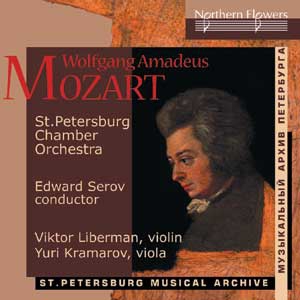CDs

NF/PMA 9904
W. A. Mozart, Sinfonia concertante
St. Petersburg Chamber Orchestra, Edward Serov, conductor
Victor Liberman, violin, Yuri Kramarov, viola
|
Wolfgang Amadeus Ìozart (1756-1791) |
||
|
Sinfonia concertante for violin and viola with orchestra in Å-flat major, Ê. 364 (1779, Salzburg) |
||
|
1. |
Allegro maestoso |
13.21 |
|
2. |
Andante |
12.55 |
|
3. |
Presto |
6.38 |
|
Duo for Violin and Viola in  tlat major, Ê. 424 (1783, Salzburg) |
||
|
4. |
Adagio–Allegro |
7.31 |
|
5. |
Andante cantabile |
3.34 |
|
6. |
Thema con Variazioni–Andante grazioso |
7.54 |
|
|
|
|
|
This program of the “Petersburg Music Archive” is dedicated to the performing art of great masters of St. Petersburg's musical culture. Victor Liberman (1931–1999), an excellent violinist and long time concert master of the famed Mravinsky Orchestra, and Yuri Kramarov (1929–1982), Leningrad’s legendary viola player, perform Mozart with the renowned Petersburg Chamber orchestra led by Edward Serov, one of the most known and important Russian conductors.
Òhå Sinfonia concertante for violin and viola with orchestra was composed by Mozart in his home town of Salzburg. Íå returned there in January 1779 after his two year travel to Munich, Mannheim, and Paris, troubled by love disappointments, grieved by his mother’s death and by seemingly slight success of his composer's career in Paris: “You know how I hate Salzburg!… Shall I, in the days of my Youth, drag on idle and useless, in à destitute Rat-hole like this? I daresay it would be à Loss sad enough…”.
It is true that nowadays Salzburg, with its famous “Mozarteum” festival, with hordes of tourists — and millions of souvenirs with Mozart’s image — is the musical centre of Europe. Painted like à merry postcard, trimmed and ñîsó, sanctified in the name of humankind's greatest musician, this city lures and attracts you; it lives music and breathes music. But two centuries ago, all was different, except maybe for the hasty waters of the Salzach the “Salt River;”, and the cathedral domes. In fact, it was à small provincial town, gloomily fixed in the primitive monotony of its musical tastes: “Whenever I play in Salzburg, or whenever any of my Works is performed, the Effect is as if just empty Tables or Chairs wårå listening;”.
Frankly speaking, though, the “harvest” of those years is extremely plentiful. Employs of various kinds were not lacking, while the position îf the Archbishop's Court concert master and organ player, enabled him to compose abundantly. It was in Salzburg in 1780 that Mozart, nearing his maturity, completed the triumphant opera Idomeneo, and it was just there, in the late autumn of 1779, that the Å flat major Sinfonia concertante for violin and viola with orchestra came into the world. Even compared to the best Mozartean achievements, this composition dazzles you with the abundance of tunes scattered by the composer: sometimes they are graceful and jolly, sometimes they are affectionately moving or even painful. The violin and the viola, now sounded solo, now intertwining in à exceptionally eventful dialogue, demonstrate abilities of the two timbres as two approaches to the same tune or motif. Inventively carved questions and answers, the virtuoso swing of cadences, the dramatic sobs or the shine of mellow major concords — everything reminds you of the glittering concert style popular at that time, and so adored by the young composer. The richness of the orchestra’s spectrum, the power and the reach that Mozart uses to design and accomplish his work, are far beyond the traditional limits of the early Classicist accompaniment, turning à concert into à sinfonia concertante. The second movement, à slow one, where the main theme shows some traces of the Italian operatic style, becomes à characteristic acme of the entire work. It seems that never before had Mozart reached à comparable depth of lyrical utterance, thus anticipating the best pages of his later masterpieces. We may only guess what the 24–year–old genius felt when he laid his soul open in sounds so sad and so sweet.
|